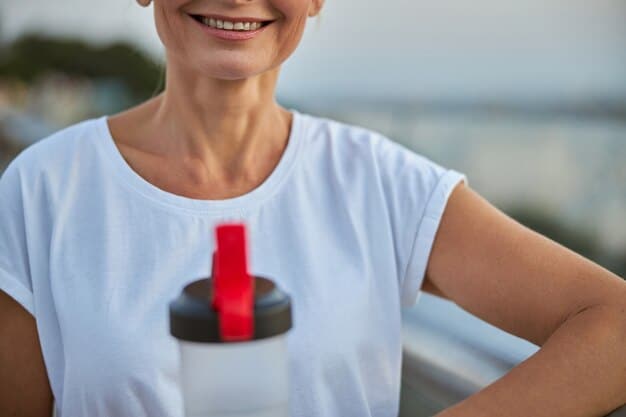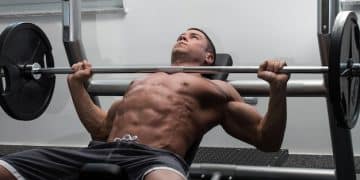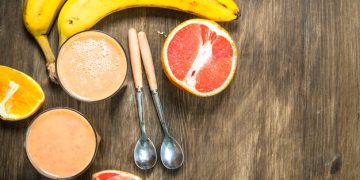Iron Supplements: Boost Energy in Female Athletes

Iron supplements are crucial for female athletes to prevent deficiency, vital for energy production and oxygen transport, ensuring peak performance and overall well-being. Addressing iron status supports athletic endurance, reduces fatigue, and optimizes recovery, essential for maintaining active lifestyles.
For female athletes, maintaining peak performance and overall well-being hinges on a delicate balance of nutrition and physiological readiness. Among the myriad factors, sufficient iron levels stand out as particularly critical. This article delves into why iron supplements: prevent deficiency and maximize energy levels for female athletes, exploring the nuances of iron metabolism, the risks of deficiency, and actionable strategies for supplementation.
The critical role of iron in female athletic performance
Iron is an essential mineral vital for numerous bodily functions, particularly those crucial for athletic endeavors. Its primary role involves the formation of hemoglobin, a protein in red blood cells that transports oxygen from the lungs to the body’s tissues, including muscles.
Beyond oxygen transport, iron is also a key component of myoglobin, the protein that stores oxygen in muscle cells, and is integral to various enzymes involved in energy production and metabolism. For athletes, these functions directly translate to stamina, endurance, and the ability to perform at high intensity.
Understanding iron’s physiological functions
Iron’s pervasive role in the body underscores its importance for athletic performance. Without adequate iron, the body cannot efficiently deliver oxygen to working muscles. This deficiency leads to a cascade of negative effects that directly impair physical capacity. Athletes, by the nature of their intense training, place higher demands on their physiological systems, making optimal iron levels even more critical.
- Oxygen transport: Hemoglobin’s ability to bind oxygen is directly proportional to iron availability. Low iron means less oxygen reaches muscles, leading to fatigue and diminished performance.
- Energy production: Iron is a cofactor for enzymes in the electron transport chain, the main pathway for ATP (energy) synthesis. Insufficient iron impairs this process, reducing overall energy levels.
- Immune function: Iron supports immune cells, and deficiency can weaken the immune system, making athletes more susceptible to illness and hindering training consistency.
Moreover, iron is involved in DNA synthesis, cell growth, and hormone production, all of which are vital for recovery and adaptation to training. The physiological strain of regular exercise inherently increases the body’s iron requirements, making female athletes particularly vulnerable to deficiencies.
Prevalence of iron deficiency in female athletes
Female athletes are disproportionately affected by iron deficiency compared to their male counterparts and non-athletic populations. Several factors contribute to this increased vulnerability, creating a complex interplay of physiological demands and lifestyle choices that can deplete iron stores.
Understanding these risk factors is the first step in prevention and effective management. Recognizing the signs early can help athletes maintain their health and performance without significant setbacks.
Key factors contributing to iron deficiency
The menstrual cycle is a primary contributor to lower iron stores in female athletes due to monthly blood loss. While menstruation is a natural process, heavy periods can significantly deplete iron over time, especially if dietary intake isn’t sufficient to compensate. This constant physiological drain places female athletes at a unique disadvantage.
Additionally, the rigorous demands of training can impact iron levels. Increased red blood cell turnover due to repetitive impact (e.g., foot strike hemolysis in runners), increased iron loss through sweat, and gastrointestinal bleeding (common in endurance athletes) all contribute to a heightened risk of deficiency. Furthermore, dietary choices, such as vegetarian or vegan diets, without proper supplementation or fortification, can exacerbate the problem.
- Menstrual blood loss: Monthly periods can lead to significant iron depletion, especially in cases of menorrhagia (heavy bleeding).
- Increased iron demand: Higher red blood cell production required by intense training accelerates iron utilization.
- Dietary habits: Insufficient intake of iron-rich foods or poor absorption due to certain dietary components (e.g., phytates in grains) can lead to deficiency.
The combination of these factors makes routine monitoring and proactive nutritional strategies, potentially including supplementation, essential for female athletes to avoid declining performance and health issues associated with low iron.
Recognizing the symptoms of iron deficiency
Iron deficiency, if left unaddressed, can severely impact an athlete’s health and performance. The symptoms can range from subtle to debilitating, often mimicking typical training fatigue, which can delay diagnosis. Early recognition is crucial for timely intervention and preventing the progression to more severe conditions like iron deficiency anemia.
It’s important for athletes to be attuned to changes in their body and performance, and to differentiate between normal training fatigue and signs of a potential underlying deficiency. A comprehensive approach involves self-awareness and professional medical evaluation.
Common signs and how they affect performance
The most common symptoms of iron deficiency are directly related to the reduced oxygen-carrying capacity of the blood. Fatigue, a pervasive and often misunderstood symptom, is generally the first indicator. This isn’t just typical tiredness from a hard workout, but a profound, lingering exhaustion that doesn’t resolve with rest.
Other symptoms include pale skin, shortness of breath during exercise, and decreased athletic performance, such as a drop in pace or difficulty maintaining intensity. Athletes might notice they are no longer achieving personal bests or are struggling to complete training sessions they previously managed with ease. These signs often point to the body’s inability to efficiently fuel intense muscular activity.
- Persistent fatigue: Chronic tiredness not alleviated by rest, affecting daily life and training.
- Reduced athletic performance: Noticeable decline in endurance, strength, or speed, with slower recovery times.
- Shortness of breath: Breathlessness during activities that previously didn’t cause it, reflecting poor oxygen delivery.
In more severe cases, symptoms can include dizziness, headaches, cold hands and feet, brittle nails, and even pica (cravings for non-food items like ice). Any combination of these symptoms warrants immediate medical consultation and a blood test to assess iron status accurately.

Diagnosing iron deficiency: Beyond the basics
Accurate diagnosis of iron deficiency in athletes requires more than just checking a complete blood count (CBC). While a CBC can indicate anemia, it may not reveal early stages of iron depletion before anemia sets in. A comprehensive iron panel provides a more detailed picture, allowing for timely intervention before performance is severely compromised.
Athletes should advocate for a full iron workup, especially if they experience persistent symptoms or are in a high-risk category. This proactive approach can prevent long-term health issues and significant dips in athletic capability.
Essential blood tests for athletes
The gold standard for diagnosing iron deficiency is a thorough iron panel, which includes several key markers. Serum ferritin is particularly important as it reflects the body’s iron stores. Low ferritin levels indicate depleted iron reserves, even if hemoglobin levels are still within the normal range. This is often the first sign of iron deficiency before anemia develops.
Transferrin saturation and total iron-binding capacity (TIBC) provide insights into how efficiently iron is being transported in the blood. A high TIBC or low transferrin saturation indicates the body is trying to absorb more iron, suggesting a deficiency. Hemoglobin and hematocrit levels measure the oxygen-carrying capacity of the blood, diagnosing anemia itself.
- Serum ferritin: The most sensitive indicator of iron stores; a low level signifies depletion.
- Hemoglobin and hematocrit: Directly measure red blood cell count and volume, crucial for diagnosing anemia.
- Transferrin saturation and TIBC: Provide information on iron transport and the body’s capacity to bind iron.
Regular monitoring, especially during periods of intense training or if symptoms arise, is highly recommended for female athletes. Consulting with a sports physician or a registered dietitian specialized in sports nutrition can help interpret results and develop a personalized plan.
Choosing the right iron supplement
Once iron deficiency is diagnosed, supplementation is often necessary to replete iron stores quickly and effectively. However, not all iron supplements are created equal, and choosing the right type and dosage is crucial for maximizing absorption and minimizing side effects. Generic recommendations may not be sufficient for an athlete’s specific needs.
Careful consideration of the form of iron, potential interactions, and side effects is vital for a successful supplementation strategy. It’s not just about taking iron, but taking it correctly to achieve desired outcomes.
Types, dosages, and absorption tips
Ferrous sulfate is a commonly prescribed and cost-effective form of iron, known for its good bioavailability. Other forms include ferrous gluconate and ferrous fumarate. For athletes, the goal is often to find a balance between efficacy and gastrointestinal tolerance. Some individuals experience stomach upset, constipation, or nausea with certain iron forms.
The typical dosage for iron deficiency is usually around 30-65 mg of elemental iron per day, but this should always be determined by a healthcare professional based on the severity of the deficiency. To enhance absorption, iron supplements should be taken on an empty stomach, or with vitamin C since ascorbic acid significantly improves iron uptake. Avoiding concurrent intake with calcium, antacids, or high-fiber foods is important as these can inhibit absorption.
- Ferrous sulfate: A widely available and effective form, though can cause GI upset.
- Elemental iron dosage: Typically 30-65 mg daily, adjusted based on medical advice.
- Enhancing absorption: Pair with vitamin C; avoid calcium, antacids, and high-fiber foods.
Some newer iron formulations, such as liposomal iron or iron bisglycinate, are marketed as having fewer side effects and better absorption. While these may be more expensive, they can be a worthwhile option for athletes who struggle with traditional iron supplements. Always consult a healthcare provider before initiating any supplementation to ensure it’s appropriate for your individual needs and to prevent potential iron overload, which can also be harmful.

Beyond supplements: Dietary and lifestyle strategies
While iron supplements can effectively address deficiencies, a holistic approach that includes dietary modifications and smart lifestyle choices is essential for long-term iron maintenance in female athletes. Supplements are a temporary solution; sustainable iron levels come from consistent, conscious decisions about food and training management.
Integrating iron-rich foods and understanding their absorption nuances is key. It’s about optimizing the intake of both heme and non-heme iron sources and minimizing factors that hinder absorption.
Optimizing iron intake through food
Iron comes in two main forms: heme iron and non-heme iron. Heme iron is found in animal products like red meat, poultry, and fish, and is highly bioavailable, meaning the body absorbs it efficiently. Non-heme iron is found in plant-based foods such as lentils, beans, spinach, and fortified cereals. While less bioavailable than heme iron, its absorption can be significantly enhanced.
To maximize non-heme iron absorption, consume it with sources of vitamin C, such as citrus fruits, bell peppers, or broccoli. For example, pairing a spinach salad with orange slices or having lentils with a tomato-based sauce can boost iron uptake. Conversely, certain compounds, like phytates in grains and legumes, calcium, and tannins in tea and coffee, can inhibit non-heme iron absorption. It’s advisable to separate their consumption from iron-rich meals.
- Heme iron sources: Red meat, poultry, fish for superior absorption.
- Non-heme iron sources: Legumes, spinach, fortified grains, paired with vitamin C.
- Absorption inhibitors: Avoid consuming calcium, phytates, and tannins with iron-rich meals.
Furthermore, managing training intensity and incorporating rest days can reduce excessive iron loss from hemolysis. For female athletes, addressing heavy menstrual bleeding with a healthcare provider can also be a critical step in managing iron levels. A balanced approach combining strategic nutrition, appropriate supplementation when needed, and mindful training practices ensures optimal iron status for peak performance and overall health.
| Key Point | Brief Description |
|---|---|
| 🏃♀️ Iron’s Role in Athletes | Crucial for oxygen transport, energy production, and overall athletic performance. |
| 🚺 Female Athlete Vulnerability | Increased risk due to menstruation, intense training, and dietary factors. |
| 🩺 Diagnosis & Symptoms | Fatigue, reduced performance, and shortness of breath; confirmed by serum ferritin. |
| 💊 Supplementation & Diet | Select appropriate iron forms; enhance absorption with Vitamin C; integrate iron-rich foods. |
Frequently Asked Questions
▼
Female athletes are at higher risk for iron deficiency due to menstrual blood loss, increased iron demand from intense training, and potential dietary restrictions. Adequate iron levels are crucial for oxygen transport, energy production, and maintaining peak athletic performance and overall health, making supplementation often necessary to prevent fatigue and poor recovery.
▼
Common symptoms include persistent fatigue unrelated to training, reduced athletic performance or endurance, shortness of breath during exercise, pale skin, and increased susceptibility to illness. These signs indicate that the body’s ability to deliver oxygen to muscles is compromised, affecting both training and competition.
▼
Diagnosis goes beyond a standard CBC. Key tests include serum ferritin, which measures iron stores, and hemoglobin/hematocrit for anemia. Transferrin saturation and total iron-binding capacity (TIBC) also provide insight into iron transport. A comprehensive iron panel is essential for accurate diagnosis and determining the severity of the deficiency.
▼
For maximum absorption, take iron supplements on an empty stomach, if tolerated. Pairing them with vitamin C (like orange juice) significantly enhances absorption. Avoid taking iron supplements with calcium-rich foods or supplements, tea, coffee, or high-fiber foods, as these can inhibit iron uptake. Consult a healthcare professional for personalized dosage recommendations.
▼
While a diet rich in iron (heme and non-heme sources) can help, it may not always be enough to prevent deficiency in female athletes due to their unique physiological demands. Consuming iron-rich foods with vitamin C can boost absorption. However, for those with existing deficiencies or high training loads, supplementation is often necessary alongside dietary changes for effective repletion and maintenance.
Conclusion
For female athletes, understanding and proactively managing iron levels are paramount to achieving peak performance and sustaining overall health. Iron deficiency can subtly yet significantly derail training, hinder progress, and compromise well-being, making awareness and timely intervention critical. By recognizing the risk factors, identifying symptoms early, pursuing comprehensive diagnostic testing, and implementing targeted supplementation and astute dietary strategies, female athletes can safeguard their iron status. This meticulous approach ensures that their bodies remain efficiently fueled for intense activity, allowing them to train harder, recover faster, and compete at their highest potential, ultimately maximizing their energy levels and preventing the silent sabotage of an often-overlooked mineral deficiency.





